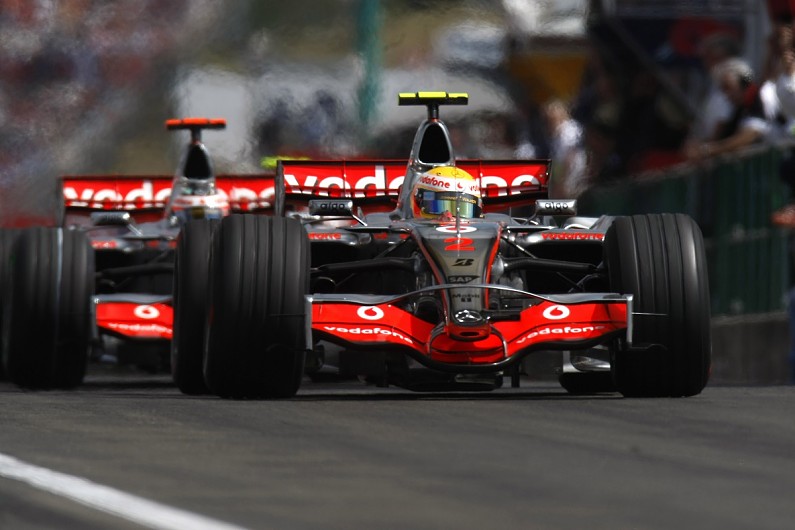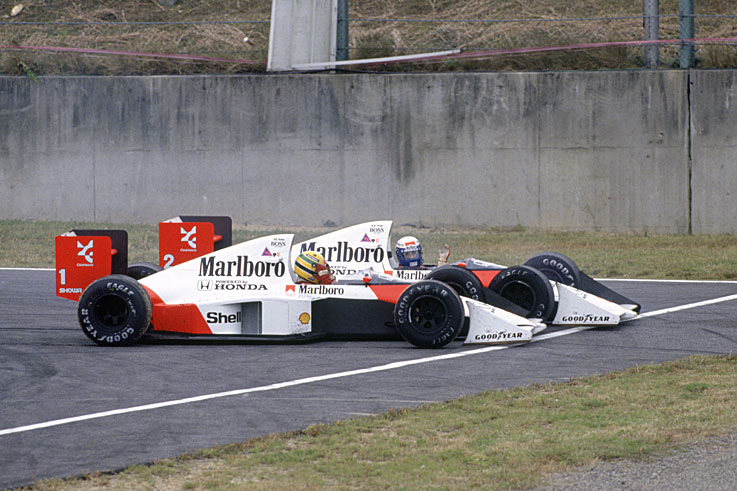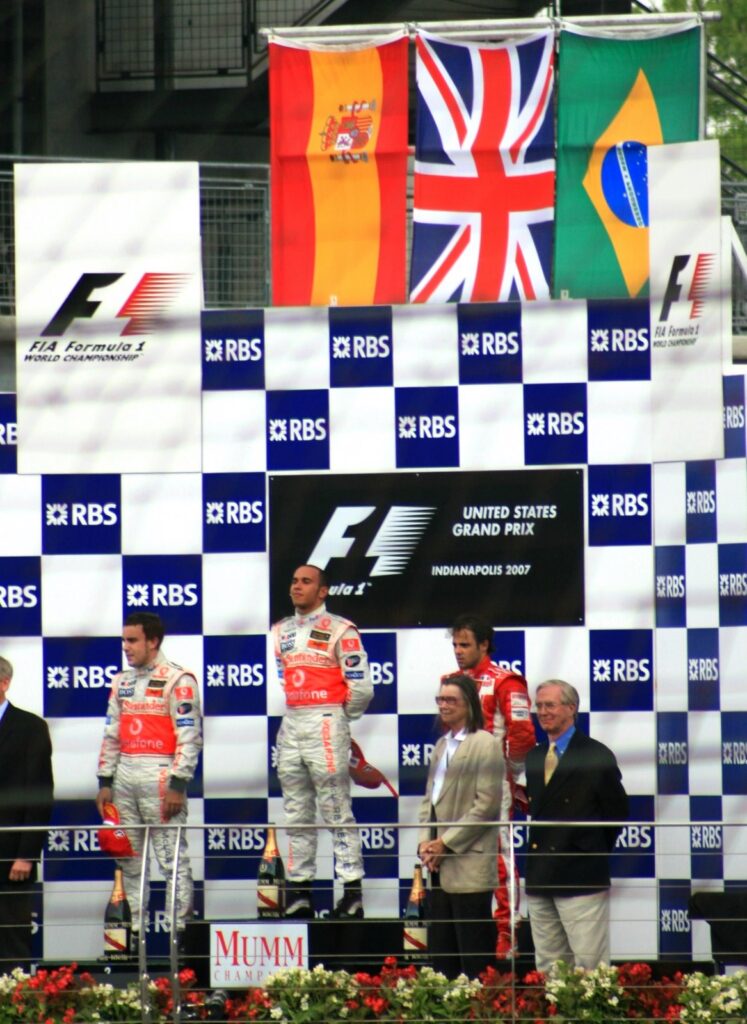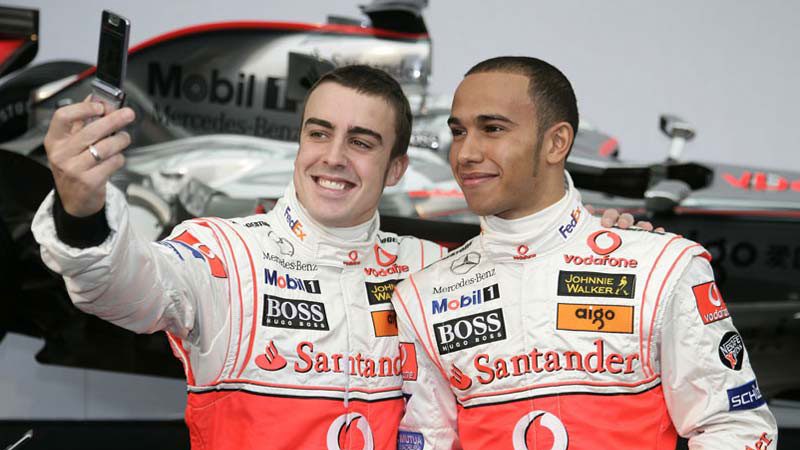INDIANAPOLIS (June 16, 2007) – To the outside world, it seems like you could cut the tension within the Vodafone McLaren-Mercedes Formula 1 team with a knife – much to the displeasure of team boss Ron Dennis.
Dennis is a man who likes to keep his team’s image as neat and tidy as the chrome-plated finish of his million-dollar racecars. Unease simmering under the surface isn’t part of the McLaren plan.
Yet that’s what his team is portraying, much to the horror of Dennis, a control-freak of legendary proportions. And he has no one but himself to blame.
The teaming of two-time World Champion Fernando Alonso with in-house development driver Lewis Hamilton is a feel-good story that Dennis turned into a train wreck with his attempts to micro-manage the media.
That’s not a surprise from a man who once showed up an hour late to a Detroit Grand Prix press conference and greeted reporters by saying, “We are making history and you are merely reporting it.”
McLaren likes to say that it makes a point of not utilizing team orders to influence the result of races. But no team has a more hands-on philosophy when it comes to controlling its drivers off the track.
The British tabloid media have understandably gone ga-ga over Hamilton, the rookie sensation who won his sixth F1 race and currently leads the World Championship. Yet they have been denied access to the driver by Dennis, who will not permit any one-on-one interviews with the 22-year old.
In creating an adversarial relationship with what he calls a “ferocious” F1 press, Dennis has made his team the scorn of Fleet Street and fans alike.
By all accounts, Alonso and Hamilton get along well as people and indeed as teammates. But Dennis’ hyper-paranoia has turned anything either of them says about each other or their relationship with the McLaren team into front-page news.
When Alonso says he feels uncomfortable in his first season at McLaren after four years with the rival Renault team, he’s not trashing Hamilton or McLaren. He’s simply being honest about how difficult it is to adapt to a new working environment. He’d feel the same if he had joined Ferrari instead.
As 1982 F1 World Champion Keke Rosberg pointed out, Alonso is a two-time World Champion, but he is a rookie at McLaren.
Conversely, Hamilton has been intimately familiar with the McLaren way since Dennis started supporting his career more than a decade ago. Hamilton rose through the ranks of karting and European single-seater racing being expressly groomed for the McLaren seat he occupies today.

If anything has upset the applecart, it has been Hamilton’s overwhelming performances from the first time he stepped into an F1 car. Fresh off his first Grand Prix win, Hamilton claimed his second pole position in succession Saturday at Indianapolis – with Alonso right on his rear wing in another McLaren 1-2.
As usual, both men said all the right things in the post-qualifying press conference. But Alonso’s defeated expression told its own story.
“I couldn’t be happier,” Hamilton smiled. “I didn’t expect to be on pole again and I really thought Fernando would be quickest.”
“I was fastest in every session except the important one,” noted a glum-looking Alonso. “I’d rather be fighting with my teammate than Ferrari, because that means the team is doing well.”
McLaren faces two problems now. At some point in the second half of the season, the team will need to put its championship effort behind one driver. What if Hamilton continues his current form and maintains a solid points lead over his higher-paid, higher-profile teammate? Will McLaren be forced to “manage” its World Champion back onto title contention?
Perhaps more importantly, if Hamilton continues to beat Alonso on a regular basis, can the McLaren drivers maintain a professional relationship? Formula 1 history shows that seriously strained teammate pairings have a shelf life of two years – or less.
Ron Dennis has been investing in Lewis Hamilton’s future for more than a decade, and the payoff has been bigger and faster than Dennis himself could have imagined. Hamilton is McLaren’s future; how soon does that make Alonso expendable?
McLaren-Mercedes circa 2007 hasn’t devolved into a toxic team – like McLaren-Honda circa 1989, for example. But it certainly has the potential to do so.
In fact, Dennis might be wise to study a page from McLaren’s past, because the team’s pairing of Ayrton Senna and Alain Prost in 1988 and ‘89 was the most antagonistic in Formula 1 history.
Then a two-time World Champion, Prost had no qualms about Dennis’ recruitment of star-on-the-rise Senna prior to the 1988 season. After all, Alain was in that very position when he joined McLaren in 1984 as understudy to veteran Niki Lauda, and throughout that season, the Frenchman was often the quicker of the two. Mainly through the luck of unreliability, Prost just lost the ’84 championship to Lauda but he won the championship in 1985 and ’86 – the latter year because feuding Williams-Honda teammates Nelson Piquet and Nigel Mansell took points from each other.
When Senna came on board at McLaren in 1988, he was immediately faster than Prost and they combined to win 15 of 16 races. Prost actually scored more points, but Senna won the championship with eight wins to Prost’s seven.
A handshake agreement at the 1989 San Marino Grand Prix changed the dynamic of the relationship. Prost took the lead at the start, winning the race in his mind. But the race was red-flagged and restarted, and this time Senna led away. When the Brazilian refused to cede the lead and won the race, Prost was incensed and vowed to no longer share data with his teammate and the two men spoke only via their engineers.
Through the summer, Prost put together a string of eight races where he won three and never finished lower than fourth. Senna also won three races in that span, but crucially, he retired from four others. That allowed Prost to accumulate an almost unassailable championship lead, but he still made paranoid claims that Senna was getting favored treatment from McLaren and engine supplier Honda.

Senna had to win the last two races of the season to win the 1989 championship, but Prost dominated the Japanese Grand Prix until Senna made a desperate attempt to pass with seven laps to go. Prost turned in, they came together. A delayed Senna won the race but was later disqualified for getting an illegal push start, guaranteeing Prost the title.
Prost switched teams to Ferrari for 1990, but the bad blood between him and Senna only got worse. They sniped at each other in the press, with Senna refusing to use Prost’s name. Senna got his retaliation for Japan ’89 exactly a year later when he intentionally drove Prost off the road at 120 mph in the first corner, somehow escaping official sanction for one of the most egregious and dangerous acts in motor racing history.
These shenanigans continued for another three years until Prost retired. Just as they were learning to become friends again, Senna was killed during the 1994 San Marino Grand Prix – ironically, at the site of the start of his feud with Prost.
Fernando Alonso is certainly not the first driver who has felt uncomfortable within McLaren’s rigid structure – Juan Pablo Montoya comes to mind – and David Coulthard might have a story or two to tell about whether some drivers really do receive favored treatment at McLaren.

Alonso is already the youngest World Champion in F1 history and Hamilton looks destined to make his own mark as one of the sport’s true greats. So maybe it’s not a surprise that there probably isn’t room for both of them in the same team.
Especially McLaren.


